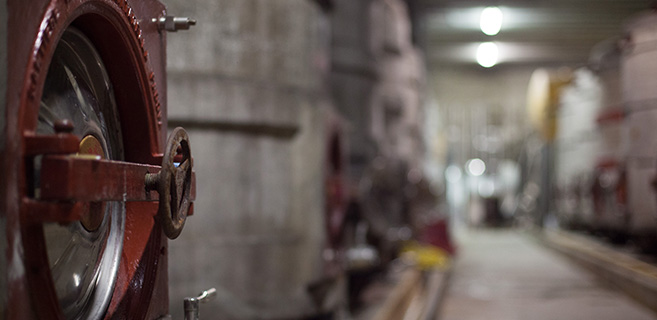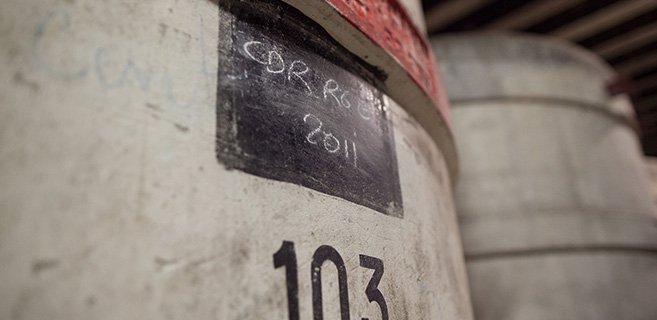
Vinification is the transformation process of grapes into wine. There are many successive steps where each choice made by the wine-maker will influence the end-quality of the wine.
The main steps go fairly quickly:
Destemming (or destalking): step which consists of separating the berries from the stalk (taking the grapes off the bunch).Keeping the stalks (referred to as the “whole” harvest) allows the wine impurities to be absorbed but an unripe stalk can give very unpleasant herbaceous aromas.
Crushing: step which consists of bursting the grapes to release the juice.
Pressuring: step which consists of pressing the grapes to recuperate the juice and have it sent to a decanting vat.
Settling of the must: settling of the juice by removing floating particles.
Alcoholic fermentation: step where the yeasts slowly change the sugar into alcohol. This step produces powerful CO2 emissions and increases the temperature in the vat. This lasts between 15 and 45 days.
This step coincides with the maceration: the must (juice) is in contact with the skin to allow the tannin and colour to be extracted.
Several methods exist to optimise this work:
- Pumping over which consists of recuperating the fermenting must accumulated at the bottom of the vat and pouring it onto the cap which floats on the vat surface,
- Rack and return which consists of recuperating the must at the bottom of the vat and pouring it into a second vat and then sending it back onto the cap,
- Punching of the cap which consists of crushing the cap into the fermenting juice by breaking it up to extract the colour and aromas.
Our working methods
The grapes, carefully picked and sorted by grape-pickers in the vineyard, are sent as is to the vinification cellar in small containers.
Upon arrival, they are transferred into a rolling receiving bin for grapes (large conical stainless steel container) which forward them to their final destination.
This installation is above the cellar allowing for the grapes to just fall into the vat where they’ll be vinified.
Vinification of White Grapes
Only white grapes picked in the morning pass through the crusher (small machine made of two rollers which burst open the grapes as they pass through) and then go down into a pneumatic pressing machine which is just below.
For the next two hours, this pressing machine, using an inflated compressed air membrane, will slowly press the bunches, extracting the juice referred to as must. The latter is then cooled down to 12° and sent into a concrete vat where it will naturally decant for 24 hours. The cleared must is then pumped into the fermentation vat and yeast is added to ensure a slow, regular, low-temperature fermentation during 4-6 weeks.
Vinification of Red Grapes
A part of them (20 to 40%) are brought directly and whole, to their fermentation vat where they burst open upon arrival after a drop of around 5 metres. Their role in the vat is important as the presence of stalks (what holds the bunches of grapes) gives the must a better draining system through the grape and thus facilitates pumping operations.
The acidity of this stalk also contributes to adding a little freshness to the grapes which are often very ripe and therefore lack acidity.
The other part is sent to the destemming-crushing machine where grapes are separated from the stalks and then burst to release part of their juice in the vat where they will ferment.
When the vat is full, a pump homogenizes the must and simultaneously adds the yeasts which will start-off the fermentation, taking 2-3 weeks between 25-30°.
During this period, pumping over operations will be carried out (pumping of the must at the bottom of the vat and sending it to the top where it will sprinkle the solid part which is floating above the must, called the cap).
This operation is to gently extract the colour and tannins in the grape skins, an extraction we amplify through rack and return. The latter consists of totally emptying the must from the vat to obtain a light pressure of the grapes under their own weight, then sending it to the top where the cap soaks in it for several hours.
Once the alcoholic fermentation phase is over, a maceration phase begins during which we’ll extract the fatty acids such as glycerol which gives wines roundness in the mouth. For this, during the pumping over, we’ll carefully try to mix the lees, making them float in what is now the wine where they’ll slowly begin to blend.


